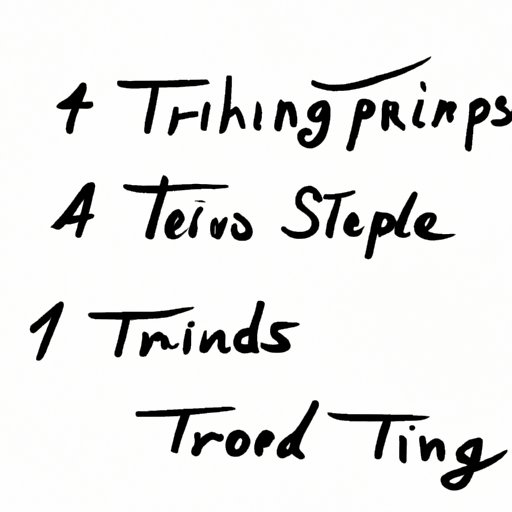
Introduction
If your handwriting is not as neat and polished as you’d like it to be, learning to write with rounded letters can be the key to a more beautiful and sophisticated script. Rounded handwriting is often associated with elegance, femininity, and creativity, but it can also be practical and easy to read. In this article, we’ll explore the art of rounded writing and provide you with practical tips and techniques to help you master this skill.
7 Simple Techniques to Master Rounded Handwriting
Before we dive into more advanced techniques for creating rounded letters, let’s start with some simple strategies that can help you get started.
Technique 1: Start with Basic Shapes
One of the easiest ways to start developing your rounded handwriting is to begin with the basic shapes that make up each letter. You can practice creating circles, ovals, and other curved lines to build up your muscle memory and get a feel for how to form rounded shapes.
Technique 2: Use Guidelines to Help You
Guidelines can be incredibly helpful when you’re starting to develop your rounded handwriting. By using pre-drawn lines to help guide the height and width of your letters, you’ll be more likely to create consistent shapes.
Technique 3: Write Slowly and Deliberately
When you’re first starting out, it’s important to take your time and write slowly and deliberately. This will help you focus on the shapes you’re creating and ensure that you’re forming each letter correctly.
Technique 4: Experiment with Different Pens and Papers
Different pens and papers can have a big impact on the look of your handwriting. Try experimenting with different ink types, pen sizes, and paper textures to see how they affect the look and feel of your writing.
Technique 5: Practice Every Day
Like any skill, mastering rounded handwriting requires practice. Try to set aside a few minutes every day to practice your writing and build up your muscle memory.
Technique 6: Pay Attention to Your Grip
Your grip on your writing instrument can have a big impact on the way your handwriting looks. Try different grips to see what feels most comfortable for you, and make sure you’re holding your pen or pencil lightly to avoid creating too much pressure.
Technique 7: Copy Styles You Admire
One of the best ways to learn any new skill is to study the work of others. Look for examples of rounded handwriting that you admire, and practice copying the style until you feel confident in creating your own unique version.
From Scribbles to a Polished Script: Tips for Creating Rounded Letters
Now that you’ve got some basic techniques under your belt, let’s dive into some more advanced tips for creating beautiful, rounded letters.
Why Rounded Letters are Important
Rounded letters can give your handwriting a softer, more elegant look. They’re often associated with femininity and creativity, but they can also be practical and easy to read.
Tips for Creating Consistent Letter Shapes
Consistency is key when it comes to creating rounded letters. Pay attention to the height and width of each letter, and try to maintain the same size and shape throughout your writing.
The Importance of Letter Spacing
Letter spacing can have a big impact on the overall look of your handwriting. Make sure you’re leaving enough space between each letter to create a clean, easy-to-read script.
Step-by-Step Guide to Developing Rounded Handwriting
If you’re ready to take your rounded handwriting to the next level, here’s a step-by-step guide to help you get started.
Step 1: Start with Basic Shapes
As we mentioned earlier, starting with basic shapes can be a great way to build up your muscle memory and get a feel for how to create rounded letters.
Step 2: Build on Your Foundation with Letters
Once you’ve mastered the basic shapes, it’s time to start working on creating individual letters. Start with one letter at a time, practicing until you feel confident in creating a consistent, rounded shape.
Step 3: Practice Writing Words
As you start getting comfortable with individual letters, try practicing writing entire words. This will help you get a feel for how your letters fit together and how to create a consistent flow.
Step 4: Pay Attention to the Details
As you continue to practice, pay attention to the details that can make a big difference in the look of your handwriting. This can include things like consistent sizing and spacing, as well as adding small embellishments to your letters for a more personalized look.
Achieving a Professional Look: How to Write with Rounded Letters
Now that you’re comfortable with the basics of rounded handwriting, it’s time to start thinking about how to make your writing look polished and professional.
What Makes Writing Look Professional
Professional-looking writing is often neat, consistent, and easy to read. When it comes to rounded handwriting, this can mean paying close attention to the sizing and spacing of your letters, and making sure that each letter is formed correctly.
Tips for Consistent Spacing and Sizing
One of the biggest challenges when it comes to creating rounded letters is maintaining consistent spacing and sizing. Here are some tips to help:
– Use guidelines to help guide your letter height and width
– Pay attention to the spacing between letters to create a clear, easy-to-read script
– Make sure each letter is the same size and shape throughout your writing
How to Create a Unified Look with Your Handwriting
Once you’ve got the basics of rounded handwriting down, it’s time to start thinking about adding your own personal touch. Creating a unified look with your handwriting can be as simple as choosing a consistent ink color or experimenting with different letter embellishments.
The Art of Rounded Writing: How to Enhance Your Penmanship
Now that you’re comfortable with the basics of rounded handwriting, it’s time to start exploring ways to add personality and style to your writing.
How to Add Personality to Your Writing
One of the simplest ways to add personality to your writing is to experiment with different writing styles. Try out different types of lettering, and don’t be afraid to add your own unique flourishes to your writing.
Using Flourishes to Elevate Your Writing
Flourishes can be a great way to add artistry and elegance to your writing. Experiment with different swirls and decorative elements to add a touch of sophistication to your letters.
Adding Personal Touches to Your Lettering Style
Finally, don’t be afraid to add personal touches to your handwriting style. Whether it’s a unique way of forming a particular letter or a special way of embellishing your writing, adding your own personal touches can make your handwriting truly one-of-a-kind.
Breaking it Down: Understanding the Mechanics of Rounded Letters
If you’re struggling with creating rounded letters, understanding the underlying mechanics can be a big help.
How Rounded Letters are Formed
Rounded letters are formed using a combination of curved lines and basic shapes. By breaking down each letter into its individual components, you can get a better sense of how to create consistent, rounded shapes.
Understanding the Anatomy of Rounded Letters
Another helpful approach is to study the anatomy of rounded letters. By understanding the different elements that make up each letter, you’ll be better equipped to create consistent shapes and sizes.
How to Troubleshoot Common Issues with Writing Rounded Letters
If you’re having trouble creating rounded letters, there may be a few common issues at play. Common issues include not enough spacing between letters, inconsistent sizing, and awkwardly formed shapes. By identifying these issues, you’ll be better equipped to address them and improve your rounded handwriting.

Embrace Your Style: How to Add Personality to Your Rounded Writing
Finally, it’s important to remember that your handwriting style is uniquely your own and should reflect your personality and preferences.
Ways to Personalize Your Handwriting Style
Personalizing your handwriting style can be as simple as experimenting with different pens and inks or incorporating flourishes and embellishments into your writing.
Experimenting with Different Styles
Don’t be afraid to try out different handwriting styles to see what resonates with you. Whether you prefer bold and dramatic strokes or subtle, understated lettering, there’s a handwriting style out there that’s perfect for you.
Finding Inspiration and Practicing Regularly
Finally, don’t forget to find inspiration for your writing and practice regularly. Whether you find inspiration in nature, art, or other sources, the more you write and experiment, the more your rounded handwriting will evolve and improve.
Conclusion
With these tips and techniques in mind, you’ll be well on your way to developing beautiful, polished rounded handwriting. Remember, like any skill, it takes practice and patience to master rounded handwriting. Keep practicing, and don’t be afraid to experiment and make the skill your own.





